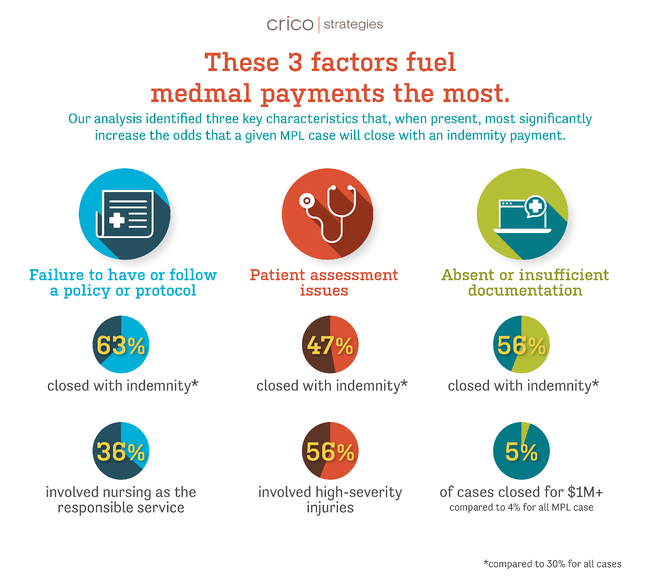The Candello Report, Power to Predict, analyzed national medical malpractice data to gain insights on which factors make malpractice claims more likely to result in an indemnity payment. The study delves deeply into processes clinicians struggle with that contribute to adverse events and can lead to malpractice claims. By understanding the common drivers—or contributing factors—of these claims, hospital leaders and clinical teams can proactively address them with confidence.
The Report found that the odds of an MPL case closing with an indemnity payment increase:
- 145% when a policy or protocol is not followed
- 85% when there are indications of inadequate patient assessment
- 76% when there are indications of insufficient documentation
The 37,000 medical professional liability (MPL) claims and suits analyzed for this Report were drawn from Candello’s MPL database—a 20-year-old national database of deeply coded medical malpractice claims with more than 450,000 cases, roughly one-third of all cases in the U.S. The inclusion of paid and unpaid medical malpractice cases in Candello—a difference from other comparably sized MPL datasets—enables the application of data models to predict the likelihood that a case will pay.
“Turning avoidable patient harm into evidence-based risk management is a key tenet of the evolving field of safety science. Understanding how today’s patient care missteps will impact tomorrow’s outcomes and financial losses has long been a capability that MPL insurers and health care providers have sought. We believe this report represents meaningful progress toward such capability.”—Mark Reynolds, President and CEO of CRICO

POLICY OR PROTOCOL NOT FOLLOWED
This analysis found that the odds of a medical professional liability (MPL) case closing with an indemnity payment increase 145% when a policy/protocol breakdown has occurred during care or treatment.
Most cases with a policy or protocol breakdown involved a policy or protocol not being followed (68%). These cases generally reflect factors about the work environment or faults within the policy’s design. Organizations need to work within a just culture framework that looks beyond the individuals to fully understand why certain policies are sidestepped.
Cases that cited a need for a policy/protocol occurred less frequently (34%) but had a higher average indemnity payment associated with them. These cases, involving an organization’s failure to establish a clinically pertinent policy, generally reflect a broader need to clarify standards for communication or evolving issues. Interventions to look at an organization’s overall policy processes can pre-empt claims associated with policy deficits.
INADEQUATE PATIENT ASSESSMENT
The analysis found that the odds of an MPL case closing with an indemnity payment increase 85% when a patient assessment failure occurred.
Candello uses 18 detail-level codes to delineate breakdowns in patient assessment, demonstrating the complexity of the clinical process and the widespread vulnerability to misunderstanding the patient’s status. Assessment errors are at the root of a high proportion of high-impact adverse events. The analysis found that the types of assessment failures contributing to these cases involved:
- Response to signs/symptoms (53%)
- Narrow diagnostic focus (36%)
- Diagnostic test ordering (33%)
- History and physical (27%)
INSUFFICIENT DOCUMENTATION
The analysis found that the odds of an MPL case closing with an indemnity payment increase 76% when there are indications of insufficient documentation.
Overall, cases in which insufficient documentation was a key contributor involve a broad range of responsible services and are more likely to derive from outpatient care. We also see that 58% were complicated by a failure to properly document clinical findings or the rationale for clinical decisions that impacted the patient’s adverse event. Certainly, some cases reflect a failure to adequately document appropriate care, i.e., documentation is primarily a defensibility issue—frequently related to the consent process.
For the complete analysis:
Download The Power to Predict.

